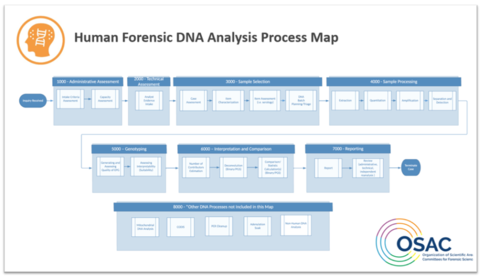
Overview of the Human Forensic DNA Analysis Process Map.
The Organization of Scientific Area Committees (OSAC) for Forensic Science’s Human Forensic Biology Subcommittee, with contributions from the Scientific Working Group on DNA Analysis Methods (SWGDAM), has developed a Human Forensic DNA Analysis Process Map that captures details about the various procedures, methods and decision points most frequently encountered in human forensic biology/DNA analysis.
Forensic science service providers make many decisions that can impact the quality and accuracy of results. Process mapping is the visual representation of critical steps and decision points of a process and is a useful tool that can help forensic science disciplines provide insight into their specific activities. The Human Forensic DNA Analysis Process Map can benefit the discipline by providing a behind-the-scenes perspective into the various components and decision points in the human forensic biology/DNA analysis process.
“A detailed process map allows us to understand the discipline in its current state. We need to fully understand a process in order to improve it,” said Beth Ordeman, Chair of OSAC’s Human Forensic Biology Subcommittee.
This process map, which captures the diverse practices of multiple laboratories from a national perspective, provides a visual description of the various steps of the casework process currently performed by DNA analysts. It is intended to be used to help improve efficiencies while reducing errors, highlight gaps where further research or standardization would be useful, and assist with training new examiners. It may also be used to develop specific laboratory policies and identify best practices.
“This process map will help us generate ideas for process improvement. Understanding how the work is currently being performed can facilitate the development of future standards and best practice documents,” Ordeman said.
OSAC is administered by the National Institute of Standards and Technology (NIST), which is working to strengthen the practice of forensic science through research and improved standards. NIST's Forensic Science Research Program facilitated the development of this process map through a collaboration with OSAC’s Human Forensic Biology Subcommittee. Additional process maps have been produced for firearms examinations, friction ridge examinations, and speaker recognition.

